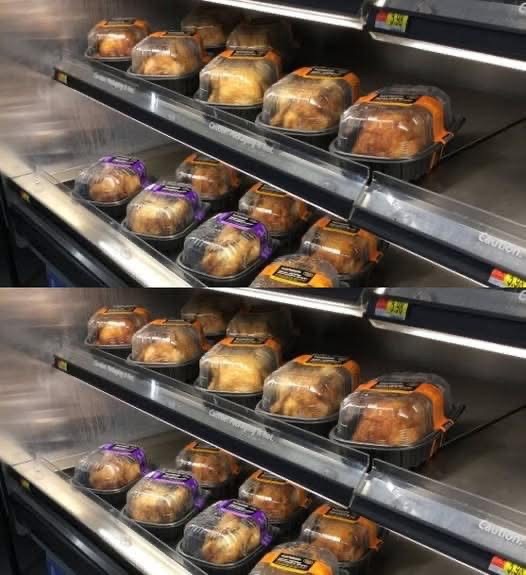
For many shoppers, Walmart’s rotisserie chicken has become the go-to “quick dinner” solution. At first glance, it seems like a win-win: a ready-to-eat, hot, and seasoned whole chicken for a price that often hovers around $4.98. The affordability, convenience, and aroma can make it feel like a deal that’s almost too good to pass up. But when you look closer, Walmart’s famous rotisserie chicken might not be the unbeatable bargain it appears to be.
The Allure of Rotisserie Chicken
Rotisserie chicken has become a staple in many American households. It saves cooking time, provides an easy protein option, and can stretch into multiple meals—think sandwiches, soups, salads, or tacos. Walmart markets its chickens as fresh, affordable, and family-sized, drawing in budget-conscious shoppers.
However, compared to similar offerings at other major grocery chains like Costco, Sam’s Club, or Kroger, there are hidden trade-offs.
The Size Factor: Smaller Chickens
One of the biggest criticisms of Walmart’s rotisserie chicken is its size. While a typical rotisserie chicken at Costco weighs around 3 pounds, Walmart’s usually comes in closer to 1.5–2 pounds. This means you’re paying less upfront, but you’re also getting much less meat.
When calculated by price per pound, Walmart’s chicken often costs more than fresh whole raw chickens sold in the same store. In some cases, you could buy a raw chicken, season it yourself, and roast it for cheaper per pound than the rotisserie option.
Flavor and Quality Issues
Another frequent complaint among shoppers is taste and texture. Many customers report Walmart’s chickens being:
- Overly salty due to the heavy use of brining solutions and sodium.
- Dry or rubbery in texture, especially when compared to competitors like Costco, which many say has juicier, more flavorful birds.
- Inconsistent in cooking—some batches come out under-seasoned, others too greasy.
In short, while convenient, the flavor doesn’t always deliver on expectations.
Hidden Sodium and Additives
Walmart’s rotisserie chickens are not simply roasted with herbs. They are often injected with solutions that can include:
- Sodium (to preserve and enhance flavor)
- Phosphates (to keep the meat moist)
- Sugar (to balance the brine)
While this keeps the chicken from drying out on the shelf, it also makes it far less healthy than many shoppers assume. A single serving can contain more than half your recommended daily sodium intake, making it a poor choice for anyone watching their blood pressure or heart health.
Value Compared to Costco and Others
The Costco rotisserie chicken, often seen as the gold standard, is not only larger but also still sold at $4.99, a price that hasn’t changed in years despite inflation. This makes Costco’s offering significantly cheaper per pound than Walmart’s.
Even grocery stores like Kroger or Sam’s Club often provide larger, juicier chickens at a better overall value.
The Convenience Trap
Walmart is banking on convenience. Shoppers on a busy day may not calculate price per pound or compare quality across stores—they just want a quick meal. This is why Walmart can sell smaller, less flavorful chickens at a lower price point and still attract customers.
But if you’re looking for true value—more meat, better taste, and fewer additives—then Walmart’s chicken may not be the smartest buy.
Alternatives and Smarter Choices
If you want to stretch your grocery budget and eat healthier, consider:
- Buying a raw whole chicken – Season and roast it at home. You’ll likely save money per pound and control the sodium levels.
- Choosing Costco’s chicken – If you have a membership, you’ll get more meat for the same price.
- Making use of leftovers – Whether from Walmart or elsewhere, repurpose the chicken into soups, casseroles, or salads to maximize value.
Final Thoughts
Walmart’s rotisserie chicken isn’t a terrible deal if you’re looking for quick convenience and don’t mind a smaller bird with higher sodium. But when you compare size, flavor, and overall value with competitors, it’s clear the “cheap chicken” may not be the bargain it first seems.
What you’re really paying for is speed and convenience—not necessarily the best price or quality. If you’re after true savings, a bit of home cooking or shopping elsewhere may serve you far better in the long run.